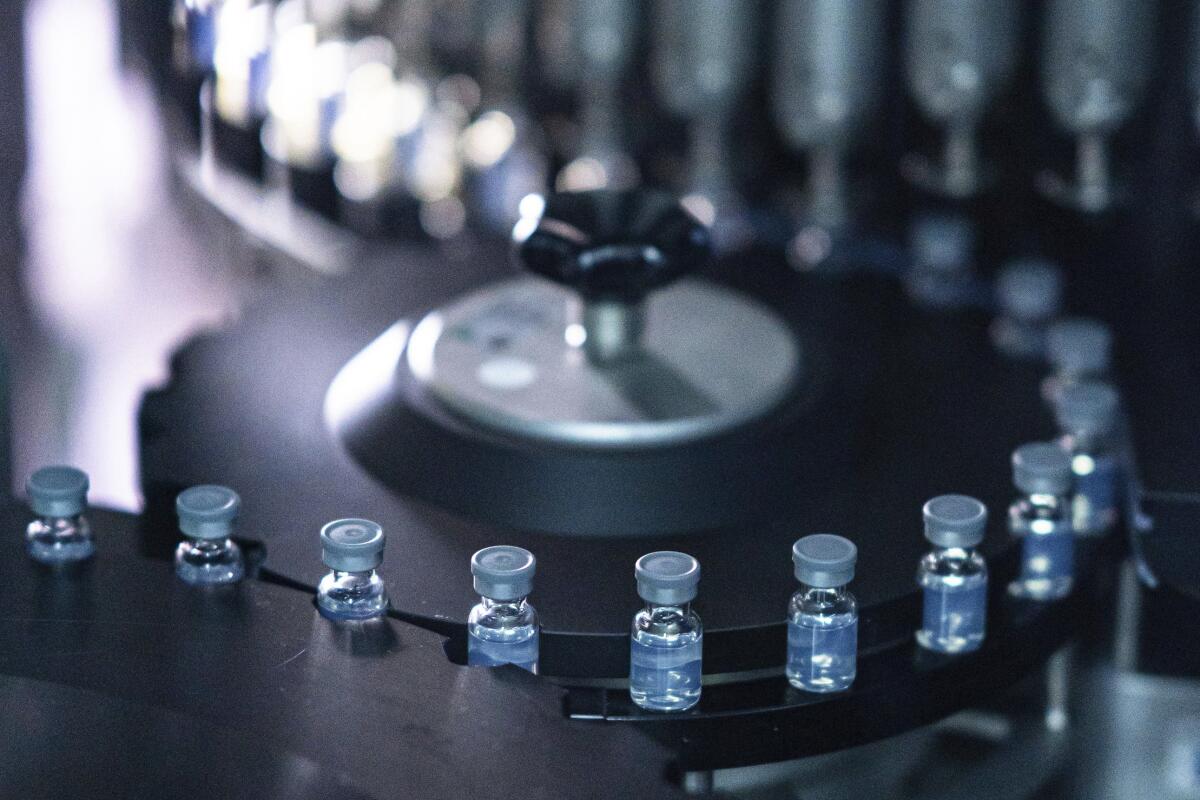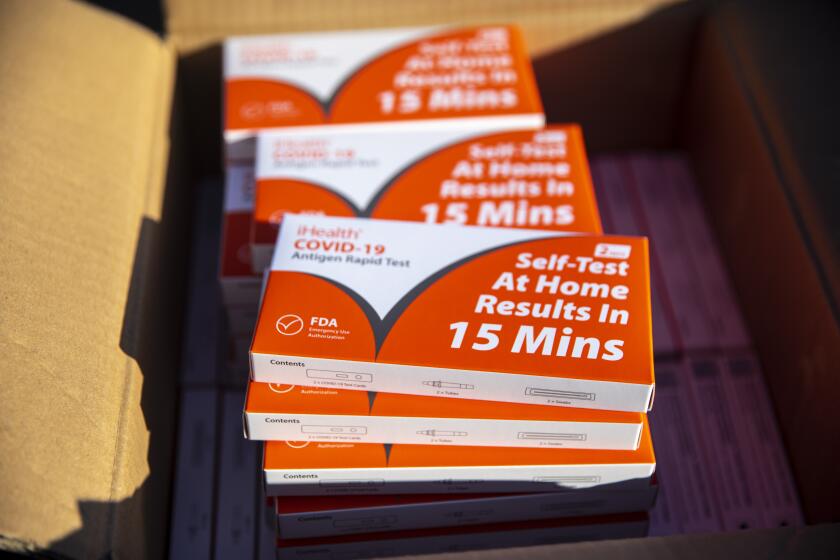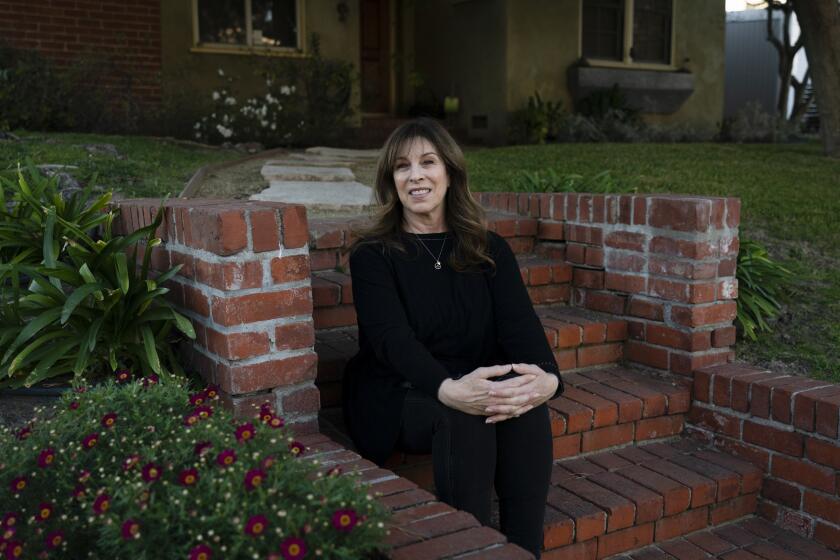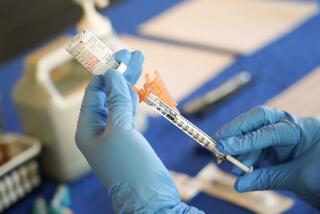Omicron booster shots in California: Am I eligible? Where can I get it? How quickly?

- Share via
New COVID-19 booster shots are rolling out in California after federal officials greenlighted a new vaccination formula targeting the latest dominant Omicron subvariants as well as the original coronavirus strain.
Who will be eligible to roll up their sleeves for these “bivalent” shots? Just how soon should people get them? And is another booster really necessary?
Here’s what we know.
Who is eligible?
The U.S. Centers for Disease Control and Prevention recommends that people ages 12 and older get the new booster shots. To be eligible, residents need to have completed their primary vaccination series and also be at least two months out from their last dose of any COVID-19 vaccine.
The updated boosters “can help restore protection that has waned since previous vaccination and were designed to provide broader protection against newer variants,” CDC Director Dr. Rochelle Walensky said in a statement Thursday.
The FDA authorized the Omicron booster from Pfizer and BioNTech for those age 12 and older. The one from Moderna is available only for adults 18 and older. Officials estimate that 209 million U.S. residents are currently eligible for the Omicron boosters.
One additional component of the timeline is independent review by the Western States Scientific Safety Review Workgroup — a coalition of public health experts from California, Nevada, Oregon and Washington. The group on Saturday signed off on the booster.
“Because protection from infection can decrease over time, the updated boosters are a safe way to maintain protection and reduce the most severe outcomes of COVID-19, such as hospitalization, long COVID, and death,” according to a joint statement from the state health and human services secretary, Dr. Mark Ghaly, and the state health officer and public health director, Dr. Tomás Aragón.
The new Omicron-specific COVID booster shots should be available for eligible residents come mid-September, officials say.
When will the Omicron boosters be available?
They’re already available in some locations. One pharmacy in downtown Los Angeles began offering the new shot Friday.
CVS, Walgreens, RiteAid are among the pharmacies that say they’re offering appointments for the updated Omicron booster.
The L.A. County Department of Public Health said the updated booster will be available as soon as Wednesday at hundreds of sites across the county, including 12 operated by the agency, more than 700 mobile vaccine clinics and nearly 250 community, pharmacy and clinic sites. Residents can look up locations at VaccinateLACounty.com. Residents can also call (833) 540-0473 between 8 a.m. to 8:30 p.m., seven days a week.
L.A. County has already pre-ordered about 170,000 doses and expects to receive them sometime between Tuesday and Friday.
California “has been allotted over 1 million doses, and will have ample supply for all those who are eligible,” the state Department of Public Health said in a statement to The Times.
Why are officials authorizing an Omicron booster?
The combination of a standard vaccination series plus a booster still does a good job of protecting against severe hospitalization and death. But as the coronavirus has evolved, the original vaccine formulations have become less effective at warding off infections, FDA Commissioner Dr. Robert Califf said at a news briefing.
The U.S. will replace most of its COVID-19 booster shots with updated versions that target the dominant Omicron strains, the CDC said Thursday.
That’s especially true when it comes to the dominant BA.5 subvariant, added Dr. Peter Marks, the FDA’s vaccine chief. BA.5 accounts for almost 89% of the coronavirus specimens now in circulation in the U.S., according to the CDC.
The CDC said coronavirus reinfections were rare during the pandemic’s first year and during the Delta surge in the summer of 2021, but the risk of reinfection “significantly increased during Omicron,” the CDC said.
Federal officials said there are benefits to launching a booster campaign right away. Modeling studies indicate that distributing boosters starting this month could prevent 137,000 more hospitalizations and 9,700 more deaths compared with beginning a booster campaign in November.
What’s in the new booster?
The new shots are known as bivalent vaccines. They’re designed to protect not only against the original coronavirus strain but also both BA.5 and another Omicron subvariant called BA.4. Both subvariants share the same spike protein on the virus’ surface.
“The hope here is that by increasing the amount of antibodies we have to that particular variant, we will restore the kind of protection that we had when we first saw these vaccines launched in the late part of 2020 and early part of 2021, where we had very good protection against symptomatic disease,” Marks said, referring to BA.4 and BA.5. “We don’t know for a fact yet whether we will get to that same level. But that is the goal here.”
Califf said these updated boosters “contain the same basic ingredients” as the already available vaccines, but they now instruct the recipient’s immune system to recognize two kinds of spike proteins instead of just one. As a result, they “are expected to help restore immune protection against COVID-19.”
The pending arrival of an Omicron booster shot marks an ambitious new phase in the nation’s vaccination campaign before a possible new COVID surge.
What evidence suggests the new boosters are safe and effective?
Califf said the original COVID-19 vaccinations have a well-documented safety record, noting they’ve been administered in billions of people worldwide.
The concept of a variant-specific bivalent vaccine has been tested in humans on a small scale before — including one against the Delta variant that fueled last summer’s surge, which ended up not being needed; and another for the original Omicron variant that emerged globally after Thanksgiving, Marks said.
Unlike the U.S., Britain opted to greenlight a booster formulation targeting the initial version of Omicron, which is known as BA.1. “They’ve shown that they produce very good immune responses in humans, and they were safe,” he said.
Clinical trials of the latest Omicron boosters are still underway, so the results in humans aren’t in yet. But health officials say that’s not a problem. They point out that the FDA and CDC approve a new version of the flu shot every year without testing it in people first. The only thing that changes is the specific mix of influenza strains targeted by the shots.
“I just would like to remind the committee that every year we use influenza vaccines that are based on new strains without clinical studies being done. This is what we do every year,” said Dr. Melinda Wharton of the National Center for Immunization and Respiratory Diseases. “There are changes made in the particular strains that are included, but overall the vaccines are the same every year. In a lot of ways this is really analogous to that.”
Available animal test data also “help bolster our impression” that the latest Omicron booster should be more effective than relying on the existing conventional vaccination, Marks added.
Waiting for full human studies to be done would likely mean it’d be too late to get people vaccinated before a possible fall-and-winter wave.
“We have to try to be a step ahead. Because if we waited for all the proof to come in, the wave will have already passed us by and the damage will have been done,” Califf said.
Even now, during a relative lull in the pandemic, there are still about 375 U.S. residents dying of COVID-19 every day. That’s “well above the around 200 deaths a day we saw earlier this spring, and in my mind, far too high for a vaccine-preventable disease,” Walensky, the CDC director, said Tuesday.
The U.S. is likely moving toward “a path with a [COVID-19] vaccination cadence similar to that of the annual influenza vaccine,” Dr. Anthony Fauci, President Biden’s chief medical advisor on the pandemic, said Tuesday.
“However, some — particularly vulnerable groups — may continue to need more frequent vaccination against COVID-19,” Fauci said at a news briefing.
Human clinical data were available for an older Omicron booster. Why not go with that one?
Marks said FDA officials chose to go with a vaccine formula that targeted BA.4 and BA.5 rather than an earlier version of Omicron because the older formula would be out of date. For the week that ended Saturday, the CDC estimated BA.4 and BA.5 combined accounted for more than 91% of coronavirus cases. The BA.1 subvariant is not a factor in the U.S., and most other Omicron subvariants have been essentially elbowed out of circulation.
Marks said he hopes the new booster will “tamp down the wave we have going through the country now and hopefully bring us the protection we need through October, November and December to prevent yet another wave that shuts down things like holiday plans.”
Should I get a booster if I’ve never gotten one?
Yes, officials say. Getting the updated booster “is a remarkable opportunity to improve our life expectancy and reduce the toll of mortality in our population,” Califf said.
“Regrettably, only about half of eligible Americans have received their first booster dose,” he said.
People who have received all of the booster doses for which they’re eligible have a 13-fold lower risk of dying from COVID-19 compared with unvaccinated people, Califf said.
The COVID.gov website says it is suspending the offering ‘because Congress hasn’t provided additional funding to replenish the nation’s stockpile.’
Will I get to choose which booster to get?
If you are 12 or older, you will have to get a bivalent booster. The only version available for adolescents ages 12 to 17 is the one from Pfizer and BioNTech. Adults could receive either that shot or the one from Moderna.
The only people who are still eligible for boosters that don’t target BA.4 and BA.5 are children ages 5 to 11. But once a bivalent version becomes available — probably in a few months — that will be the only booster option for them as well.
If I haven’t been vaccinated, will I get the new formula?
No. The primary vaccination series is still based on the original formula.
“We’re considering this a transitional year, where we feel like everyone needs to get this base of immunity that we understand really well,” Marks said. “And we believe that building on that is important.”
For an unvaccinated person looking to get up to date, that would mean getting an initial two-dose series, with the shots spaced a few weeks apart depending on the brand, followed by a bivalent booster at least two months later.
It’s sometimes hard to grasp COVID-19’s destruction. But a drop in U.S. life expectancy brings the pandemic’s toll into focus.
Why would I need to wait at least two months?
Many Americans — including the vast majority of people younger than 50 — got their last COVID-19 vaccination or booster shot more than half a year ago.
Getting too many shots “right on top of one another may not have the kind of immune response that one would like,” Marks said.
But the FDA and CDC also wanted to avoid an extended waiting period between shots.
“In terms of trying to stave off serious outcomes and symptomatic disease, one needs to refresh the immune system with what is actually circulating,” Marks said.
Although the CDC’s official recommendation says the booster can be given as long as two months since the person’s last shot, the agency’s vaccine advisors stressed that most people would be better off with a longer interval.
Studies have shown that boosters have a bigger effect after several months have passed. Anyone who has gone more than six months since their last shot shouldn’t wait to get the new booster, they said.
What if I just had COVID-19? Can I still get the booster right away?
No. In that case, you’ll probably need to wait three months since you tested positive for an infection or you experienced your first COVID-19 symptoms, whichever came first. But the CDC said other factors could alter the timing, such as the level of COVID-19 in the community and the person’s risk factors for severe disease.
The reason for the delay is the same as getting too many shots too close together — it blunts the booster’s impact.
Can I get the COVID-19 booster and the flu shot, or another vaccine, at the same time?
Yes. In fact, the CDC says that healthcare providers should offer flu and COVID-19 vaccines at the same visit to people who are eligible. “Getting both vaccines at the same visit increases the chance that a person will be up to date with their vaccinations,” the CDC said in a presentation.
The agency suggested administering each shot in separate limbs.
“I really believe this is why God gave us two arms — one for the flu shot and the other one for the COVID shot,” quipped Dr. Ashish Jha, the White House COVID-19 response coordinator.
Other vaccines are fine, too, unless there’s a specific reason not to at the time of the healthcare visit. “Providers should offer all vaccines for which a person is eligible at the same visit,” the CDC said.
Californians’ average life expectancy fell by two years due to COVID and drug overdoses, according to the Centers for Disease Control and Prevention.
Will people actually get the new booster?
Time will tell. Nationwide, about 68% of residents have completed their primary vaccination series. Of them, only 49% have received at least one booster.
The CDC presented survey data suggesting that 72% of respondents said they were likely to receive an updated booster.
Can I get the booster while sick with COVID?
No. The CDC advises delaying any COVID-19 vaccination or booster shot administration at least until a person has recovered from acute illness.
As unprecedented numbers of Omicron subvariants continue to fuel a new coronavirus wave, there is growing alarm about long COVID, in which symptoms or increased risk of illness can persist for months or even years.
Can getting a booster reduce the chance of long COVID?
Marks said he thinks so. For people who have only had their primary two-dose vaccination series, getting a booster “can probably reduce — by more than half — their chance of long COVID if they get COVID-19,” Marks said.
And if the new booster reduces your risk of becoming infected and developing COVID-19 in the first place, it would certainly reduce your risk of long COVID.
Times staff writers Corinne Purtill and Ben Welsh contributed to this report.
More to Read
Sign up for Essential California
The most important California stories and recommendations in your inbox every morning.
You may occasionally receive promotional content from the Los Angeles Times.






















